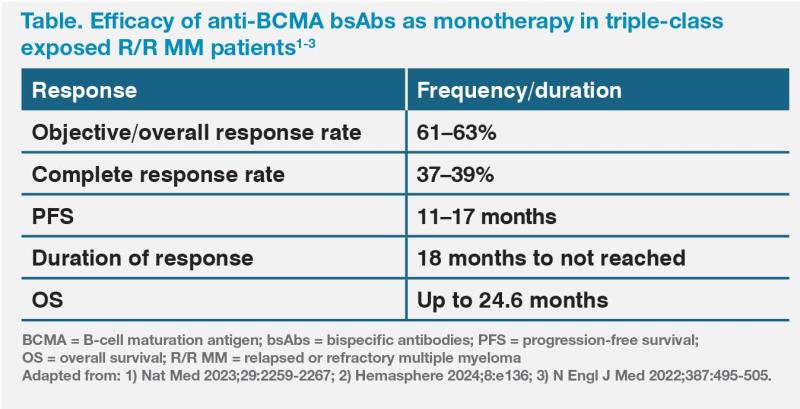Evolving treatment landscape in R/R MM: Challenges and advances





Treatment of relapsed or refractory multiple myeloma (R/R MM) remains challenging due to resistance to standard-of-care (SoC) therapies, leading to a poor prognosis. In an interview with MIMS Oncology, Dr Karen Hoi-Ki Tang, Specialist in Haematology & Haematological Oncology in Hong Kong, discussed unmet needs in managing R/R MM and the role of latest therapeutic options.
MM treatment landscape
In Hong Kong, quadruplet induction therapy comprising an anti-CD38 monoclonal antibody (mAb), a first-generation proteasome inhibitor (PI), an immunomodulatory drug (IMiD), and dexamethasone has become the SoC for newly diagnosed MM. Maintenance treatment involves a second-generation IMiD in transplant-ineligible patients, and autologous stem cell transplantation followed by a second-generation IMiD in transplant-eligible patients. “For frail patients, a triplet induction regimen without a PI may be considered, followed by continuous anti-CD38 mAb and a second-generation IMiD as maintenance therapy,” noted Tang. [Ann Oncol 2021;32:309-322; NCCN Clinical Practice Guidelines in Oncology, Multiple Myeloma, version 2.2026]
At relapse, treatment decisions depend on patients’ age, performance status (PS), comorbidities, disease characteristics, and prior treatments. “Most patients at first relapse are refractory to second-generation IMiD, while a minority are refractory to both a second-generation IMiD and an anti-CD38 mAb, depending on the maintenance treatment they received,” explained Tang. [Ann Oncol 2021;32:309-322; NCCN Clinical Practice Guidelines in Oncology, Multiple Myeloma, version 2.2026; Antibodies (Basel) 2023;12:38]
Unmet needs in R/R MM
With potent agents and former second- or third-line drugs now used as combination therapy in the frontline, treatment options at relapse can be quickly exhausted due to prior exposure to these agents early in the disease course. [Mediterr J Hematol Infect Dis 2025;17:e2025045; Ann Oncol 2021;32:309-322; Leukemia 2024;38:2554-2560]
“Most patients become triple-class refractory after two to three lines of treatment and effective therapeutic options were previously limited,” highlighted Tang.
In the past, R/R MM patients were usually rechallenged with previously used agents. Other available therapies came with limitations. “B-cell lymphoma 2 inhibitors have shown benefits in the t(11;14) translocation subset only, but are not registered for MM and cannot be reimbursed. For better efficacy, anti–B-cell maturation antigen [BCMA] mAb drug conjugate needs to be used in combination with conventional agents such as IMiDs or PIs, of which many existing R/R MM patients may already be refractory to,” said Tang. “Chemotherapy may sometimes be used in patients with rapidly progressive disease, but it is not very effective”. [Leukemia 2024;38:2554-2560; Ann Oncol 2021;32:309-322; Blood Lymphat Cancer 2024:14:71-87; Blood Lymphat Cancer 2021:11:11-24]
The prospective, observational LocoMMotion study revealed that triple-class exposed R/R MM patients had a median progression-free survival (PFS) of only 4.6 months and a median overall survival of 13.8 months, underscoring an urgent need for novel therapies in this underserved population. [Leukemia 2024;38:2554-2560]
New era with anti-BCMA bsAbs
“We now have more treatment options, including anti-BCMA bispecific antibodies [bsAbs], anti-GPRC5D bsAbs, and chimeric antigen receptor [CAR] T-cell therapy,” highlighted Tang. “Of these, we currently have the most experience using anti-BCMA bsAbs due to their availability, accessibility, ease of administration, and cost.”
Anti-BCMA bsAbs have established a key role in the new treatment era as monotherapy for triple-class exposed R/R MM patients who have received ≥3 prior therapies, including an IMiD, a PI, and an anti-CD38 mAb, and have experienced disease progression on their last treatment. Durable responses and survival benefits have been shown in these heavily pretreated patients, with duration of response not reached and an overall survival of 2 years. (Table) [Elranatamab Hong Kong Prescribing Information; NCCN Clinical Practice Guidelines in Oncology, Multiple Myeloma, version 2.2026; Antibodies (Basel) 2023;12:38; Hemasphere 2024;8:e136]

“Compared with results reported in LocoMMotion, anti-BCMA bsAbs, even as monotherapy, greatly improve survival in R/R MM patients,” noted Tang.
Common adverse events (AEs) of anti-BCMA bsAbs include anaemia, thrombocytopenia, neutropenia, infections, and low-grade cytokine release syndrome (CRS). Complete blood counts should be monitored regularly to manage haematologic AEs. Infection management may involve frequent blood monitoring, cytomegalovirus prophylaxis, as well as immunoglobulin replacement and antifungal prophylaxis when needed. [Antibodies (Basel) 2023;12:38; Front Oncol 2024:14:1394048; NCCN Clinical Practice Guidelines in Oncology, Multiple Myeloma, version 2.2026; Ann Oncol 2021;32:309-322]
“In cases of grade 3–4 infections, anti-BCMA bsAbs should be withheld while patients are hospitalized. If the interruption lasts only 1–2 weeks, treatment may be resumed at the same dose. For longer interruptions, reinitiation with step-up dosing may be necessary,” explained Tang. “If infections occur frequently, dosing intervals may be extended. This approach may help reduce infection rates while still maintaining response.”
In a post-hoc analysis of a phase II trial evaluating the efficacy of less frequent dosing of an anti-BCMA bsAb in BCMA-naïve R/R MM patients, 92 percent of patients maintained their response ≥6 months after switching the dosing frequency from Q2W to Q4W. [Blood 2024;144:4738]
Anti-BCMA bsAbs offer an “off-the-shelf” advantage with no manufacturing time, making them suitable for patients with rapidly progressing disease who cannot wait for CAR T-cell therapy. They are generally well tolerated, with low incidences of severe CRS and immune effector cell–associated neurotoxicity syndrome (ICANS). With minimal restrictions on patient eligibility, anti-BCMA bsAbs are appropriate even for those with renal impairment or poorer PS. [Mediterr J Hematol Infect Dis 2025;17:e2025045; Elranatamab Hong Kong Prescribing Information]
CAR T-cell therapy
CAR T-cell therapy is a highly effective, one-time treatment with longer reported PFS than anti-BCMA bsAbs. However, it requires patients to be physically fit. Patients need to be evaluated for comorbidities to ensure sufficient organ function to withstand the potential impact of chemotherapy, CRS, ICANS, and prolonged cytopenia. While the strict eligibility criteria make it unsuitable for many elderly patients with poor PS, CAR T-cell therapy could be attractive to younger patients seeking durable remission and prolonged treatment-free periods. Notably, CAR T-cell therapy presents more logistical challenges than anti-BCMA bsAbs, including the need for approval from local authorities, limited accessibility (only at dedicated centres), a waiting time of several weeks for CAR-T cell manufacturing, and careful timing to stop treatment before T cell apheresis and before CAR-T cell reinfusion. [Mediterr J Hematol Infect Dis 2025;17:e2025045]
“Overall, anti-BCMA bsAbs are more accessible to haematologists, more affordable, and easier to administer than CAR T-cell therapy,” concluded Tang. “For the substantial R/R MM population ineligible for CAR T-cell therapy, anti- BCMA bsAbs are the first treatment of choice when patients become triple-class refractory and can also be used after CAR T-cell therapy if patients relapse.”